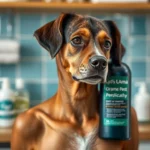
Introduction
Maintaining your dog’s health is an integral part of responsible pet ownership. Among the various health concerns dog owners face, flea infestations are one of the most common and troublesome issues. Fleas not only cause discomfort for our furry friends but can also lead to serious health problems if left untreated. One of the most effective ways to protect your dog from these pesky parasites is by choosing the best flea collar for dogs. Selecting the right collar ensures your pet is both comfortable and safeguarded against fleas.
Understanding Fleas and Their Impact on Dog Health
What Are Fleas?
Fleas are small, wingless insects that belong to the order Siphonaptera. They are external parasites that feed on the blood of mammals and birds. Fleas have a complex lifecycle that includes four stages: egg, larva, pupa, and adult. An adult flea can lay up to 50 eggs per day, which can lead to rapid infestations if not addressed promptly. The most common types of fleas affecting dogs include the Ctenocephalides canis (dog flea) and Ctenocephalides felis (cat flea), both notorious for their adaptability and resilience.
Health Risks Associated with Fleas
Fleas pose several health risks to dogs. The most immediate concern is skin irritation and allergic reactions, which can lead to intense scratching, biting, and secondary infections. Some dogs may develop flea allergy dermatitis (FAD), a condition that causes severe itching and inflammation.
Fleas can also transmit various diseases. For instance, they can carry tapeworms, which dogs can ingest when they groom themselves. Another significant concern is Bartonella, a bacterium that can lead to serious health issues. In severe infestations, fleas can cause anemia, particularly in young or elderly dogs, due to blood loss.
Recognizing Flea Infestations
Identifying a flea infestation early is crucial for effective treatment. Common symptoms include:
- Excessive scratching or biting at the skin
- Red, inflamed skin or hot spots
- Hair loss or thinning fur
- Flea dirt (small black specks) on the skin or in the fur
- Restlessness or changes in behavior
To check your dog for fleas, run your fingers through their fur, especially around the ears, neck, and base of the tail. A flea comb can also be useful in identifying fleas and flea dirt.
The Role of Flea Collars in Dog Health Care
How Flea Collars Work
Flea collars operate through different mechanisms, primarily relying on chemical or natural ingredients. Chemical collars use insecticides to kill fleas upon contact, while natural collars often utilize plant-based ingredients that repel fleas. The effectiveness of these collars can last from several months to a year, depending on the product.
Benefits of Using Flea Collars
Flea collars provide several advantages:
- Continuous Protection: Unlike topical treatments that may wash off, collars offer ongoing defense against fleas.
- Ease of Use: Collars are simple to apply and require minimal maintenance compared to other methods.
- Cost-Effectiveness: Many flea collars provide long-lasting protection, making them a budget-friendly option for flea control.
Limitations of Flea Collars
While flea collars are beneficial, they also have limitations:
- Potential Side Effects: Some dogs may experience skin irritation or allergic reactions to the chemicals used in certain collars.
- Not Suitable for All Dogs: Puppies, pregnant dogs, and those with specific health conditions may require alternative flea control methods.
- Combining Methods: For optimal effectiveness, flea collars should be used in conjunction with other flea control methods, such as regular grooming and home treatments.
Choosing the Best Flea Collar for Dogs
Factors to Consider
When selecting the best flea collar for dogs, consider the following factors:
- Dog Size and Weight: Ensure the collar is appropriate for your dog’s size. Many collars are designed for specific weight ranges.
- Age and Health Condition: Check if the collar is suitable for your dog’s age and any underlying health issues.
- Environment: Consider whether your dog is primarily an indoor or outdoor pet, as outdoor dogs may require more robust flea protection.
Types of Flea Collars
Flea collars come in various types, including:
- Chemical-Based Collars: These contain insecticides that kill fleas on contact.
- Natural/Organic Collars: Made with plant-based ingredients, these collars repel fleas without harsh chemicals.
- Water-Resistant Options: Ideal for dogs that enjoy swimming or frequent baths, these collars maintain effectiveness even when wet.
Top Recommendations for Flea Collars
Seresto Flea and Tick Collar
The Seresto Flea and Tick Collar is highly regarded for its long-lasting protection. It uses a combination of imidacloprid and flumethrin to kill fleas and ticks within 24 hours of application. Effective for up to eight months, it is water-resistant and suitable for dogs of all sizes. Many customers praise its effectiveness and ease of use, highlighting a noticeable decrease in flea activity.
Hartz UltraGuard Pro Reflective Flea Collar
The Hartz UltraGuard Pro Reflective Flea Collar provides protection against fleas and ticks for up to seven months. Featuring a reflective design for added visibility, it helps keep your dog safe during nighttime walks. Users report positive outcomes in flea prevention, making it a reliable choice for budget-conscious pet owners.
PetArmor Flea and Tick Collar
The PetArmor Flea and Tick Collar is designed to kill fleas and ticks on contact, offering protection for up to six months. It is effective for dogs of various sizes and has garnered positive reviews for its affordability and effectiveness. Pet owners often note a reduction in flea-related issues shortly after application.
Scalibor Protector Band
The Scalibor Protector Band is a veterinary-recommended collar that provides protection against fleas and ticks for up to six months. It works through the slow release of an active ingredient that disperses across the dog’s skin and fur. Its long-lasting effectiveness and water-resistant features make it a popular choice among dog owners.
Natural Alternatives (e.g., Wondercide Flea and Tick Collar)
For those seeking a more holistic approach, the Wondercide Flea and Tick Collar offers a natural alternative. Made from plant-based ingredients, it repels fleas and ticks without toxic chemicals. Users appreciate its safety for pets and children, as well as the pleasant scent. While it may require more frequent replacement, many find it effective for mild infestations.
How to Properly Use Flea Collars
Application Guidelines
To apply a flea collar correctly:
- Remove the collar from the packaging and unfasten it.
- Place the collar around your dog’s neck, ensuring it’s snug but not too tight; you should be able to fit two fingers between the collar and your dog’s neck.
- Cut off any excess length to prevent your dog from chewing on it.
- Fasten the collar securely.
Maintenance Tips
Maintaining your flea collar is important for its effectiveness:
- Cleaning: Wipe the collar with a damp cloth to remove dirt and debris.
- Replacing: Check the collar regularly for signs of wear or damage. Replace it according to the manufacturer’s recommendations or if you notice a resurgence of fleas.
Monitoring Your Dog
Regularly check your dog for fleas and assess the collar’s effectiveness. If you notice fleas despite using the collar, consult your veterinarian for alternative treatments or additional measures.
Complementary Flea Prevention Strategies
Regular Grooming and Bathing
Grooming your dog regularly not only helps remove fleas but also promotes a healthy coat. Use a flea comb to catch any fleas or flea dirt. Consider bathing your dog with a flea shampoo, but consult your vet for recommendations based on your dog’s specific needs.
Home Treatment and Pest Control
To effectively manage fleas, treat your home as well. Wash your dog’s bedding and vacuum carpets regularly. Consider using flea sprays or powders specifically designed for home use. Ensure that any products used are safe for pets and children.
Routine Veterinary Check-ups
Regular veterinary visits are crucial for maintaining your dog’s health. Discuss flea prevention options with your vet and ensure your dog is up to date on vaccinations and preventive medications. Your vet can provide personalized recommendations based on your dog’s health and lifestyle.
Conclusion
Flea control is essential for your dog’s overall health and well-being. By understanding the risks associated with fleas and the benefits of using a best flea collar for dogs, you can provide your pet with the protection they need. Remember to choose a collar that fits your dog’s size, age, and lifestyle, and consider integrating it with other flea prevention strategies for the best results. Taking proactive measures will help ensure that your furry friend remains happy, healthy, and flea-free.









